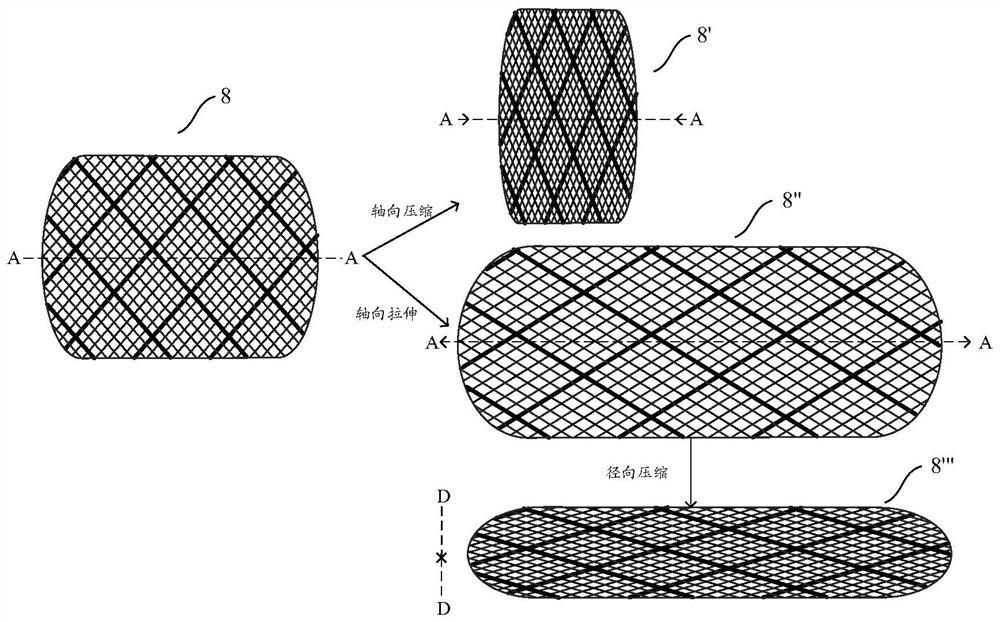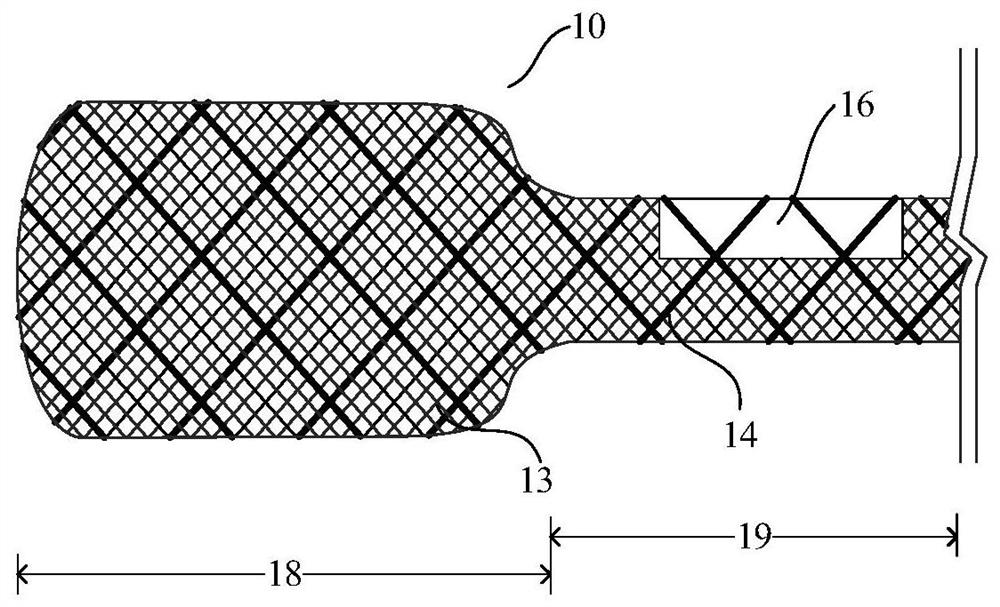Stent, stent set and stent delivery system
A technology of radial support and metal, applied in stents, medical science, prostheses, etc., can solve the problems of insufficient radial support force of stents, difficult placement of transmission systems, impractical implementation, etc.
- Summary
- Abstract
- Description
- Claims
- Application Information
AI Technical Summary
Problems solved by technology
Method used
Image
Examples
Embodiment approach
[0133] According to one embodiment, the stent of the present invention can be braided from three or more wires with different diameters. Such as Figure 6 , which shows a partially enlarged schematic view of a single layer of the scaffold of this embodiment. The stent is braided by a first wire 33 and two second wires 34a, 34b. Wherein the first wire 33 is a thin wire, which may have a diameter of 20-150 μm, preferably 50-150 μm. The second wires include first thick wires 34a, which may have a diameter of 150˜300 μm, and second thick wires 34b, which may have a diameter of 300˜600 μm. Among them, 6 to 12 strands can be used for the first thick strands, more than 4 strands can be used for the second thick strands, but no more than 12 strands at most, and the rest are the first strands. This embodiment also has other variants, such as two kinds of first filaments (for example, with diameters in the range of 20-100 μm and 100-150 μm, respectively) and one second filament, or t...
Embodiment 1
[0162] This embodiment provides figure 1 Stent of the structure shown, the stent is used in the region of the descending aorta. The stent is made of nickel-titanium alloy material and is formed by interweaving 54 first wires with a diameter of 100 μm and 12 second wires with a diameter of 400 μm. The stent is braided in 2 layers in the way of back braiding. Compilation method such as Figure 5 As shown in middle A, the proximal end is the smooth end of the braiding, and the distal end is two layers of hair. A small section of the outer burr is woven back, and the inner burr is placed inside the back-weaving section to prevent the burrs from being exposed and damaging the vessel wall.
[0163] The stent is tapered; the diameter of the proximal end is 45 mm, and the diameter of the distal end is 32 mm; the length is 8 cm. The stent can be fixed in length up to 24cm after being released in the blood vessel.
[0164] The metal coverage of the stent in this embodiment is 40% in...
Embodiment 2
[0167] This embodiment provides image 3 A stent of the configuration shown, used in the region of the ascending aorta to the aortic arch. The stent is made of nickel-titanium material and is formed by interweaving 120 first wires with a diameter of 100 μm and 8 second wires with a diameter of 400 μm. The stent is braided in 4 layers in the way of back braiding. Compilation method such as Figure 5 As shown in middle C, the proximal end is a smooth end that is fully back-braided, and the distal end is two layers of burrs placed on the inside of the stent, and two layers of back-braided edges are placed on the outside of the stent to prevent the burrs from being exposed and damaging the vessel wall.
[0168] The diameter of the part corresponding to the ascending aorta of the stent is 45 mm, and the length is 9 cm; the diameter of the part corresponding to the aortic arch is 32 mm, and the length is 6 cm. At a distance of 30mm from the proximal end of the stent, there is a n...
PUM
| Property | Measurement | Unit |
|---|---|---|
| Diameter | aaaaa | aaaaa |
| Diameter | aaaaa | aaaaa |
| Diameter | aaaaa | aaaaa |
Abstract
Description
Claims
Application Information
 Login to View More
Login to View More - R&D
- Intellectual Property
- Life Sciences
- Materials
- Tech Scout
- Unparalleled Data Quality
- Higher Quality Content
- 60% Fewer Hallucinations
Browse by: Latest US Patents, China's latest patents, Technical Efficacy Thesaurus, Application Domain, Technology Topic, Popular Technical Reports.
© 2025 PatSnap. All rights reserved.Legal|Privacy policy|Modern Slavery Act Transparency Statement|Sitemap|About US| Contact US: help@patsnap.com



